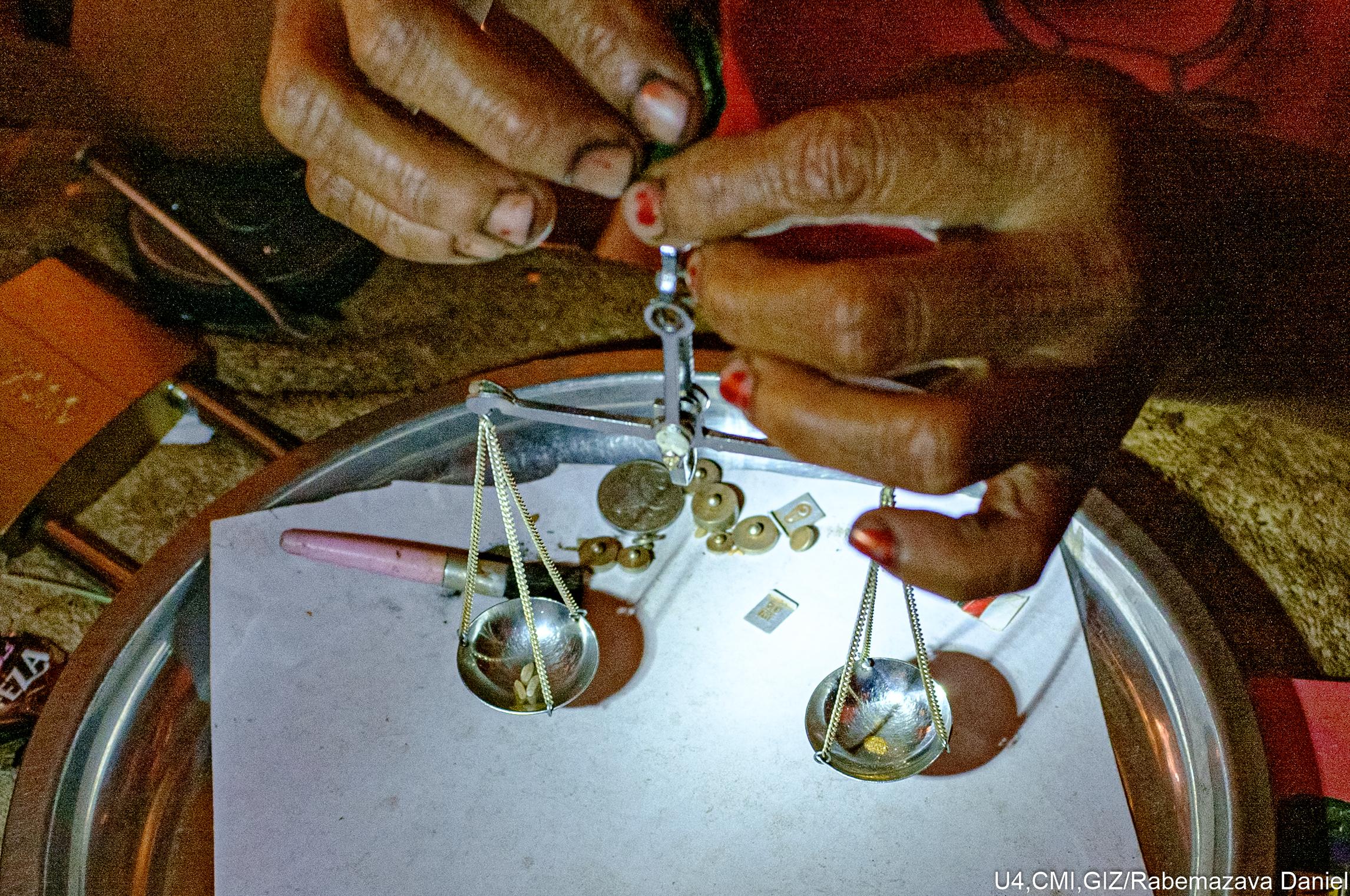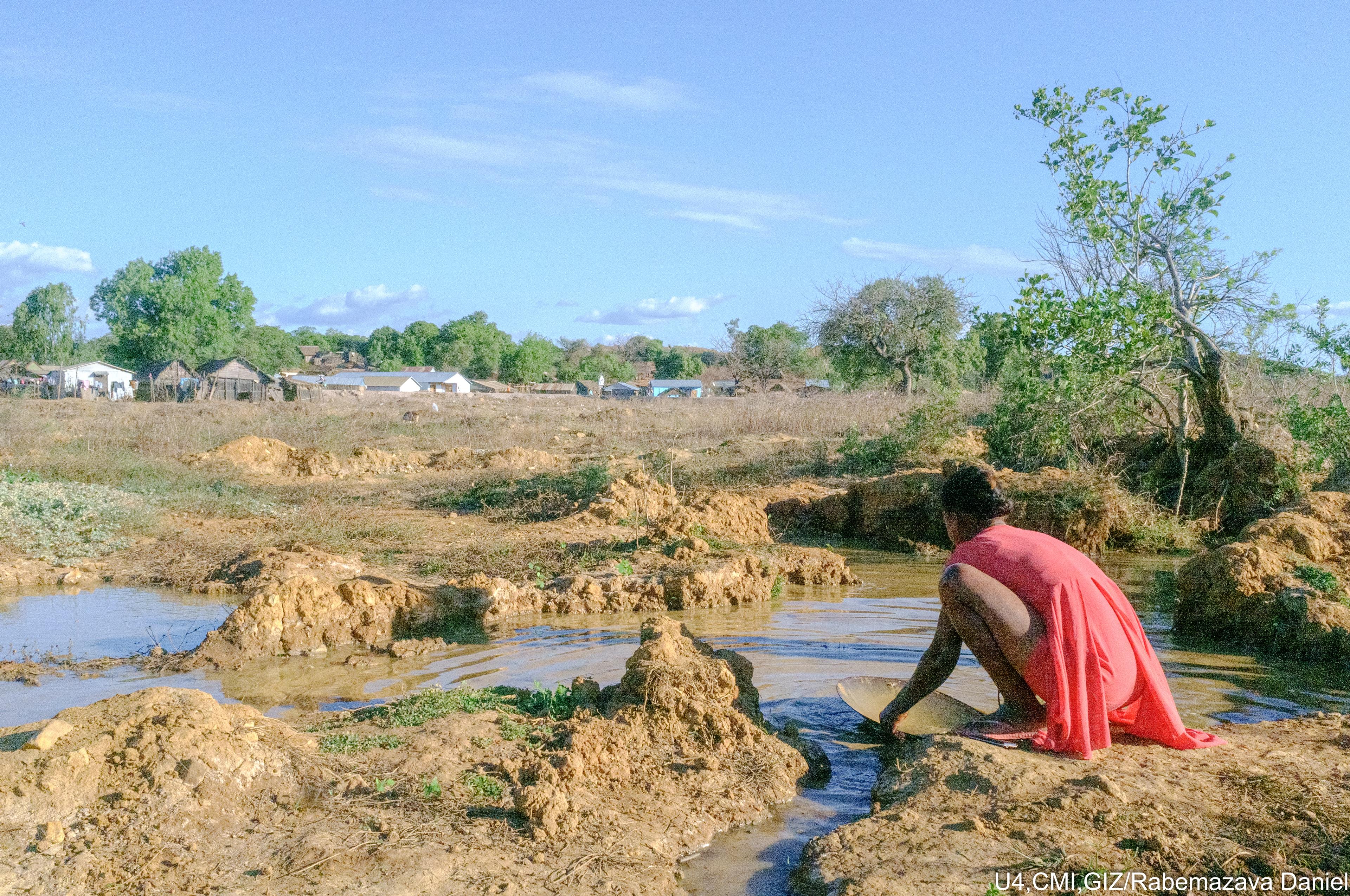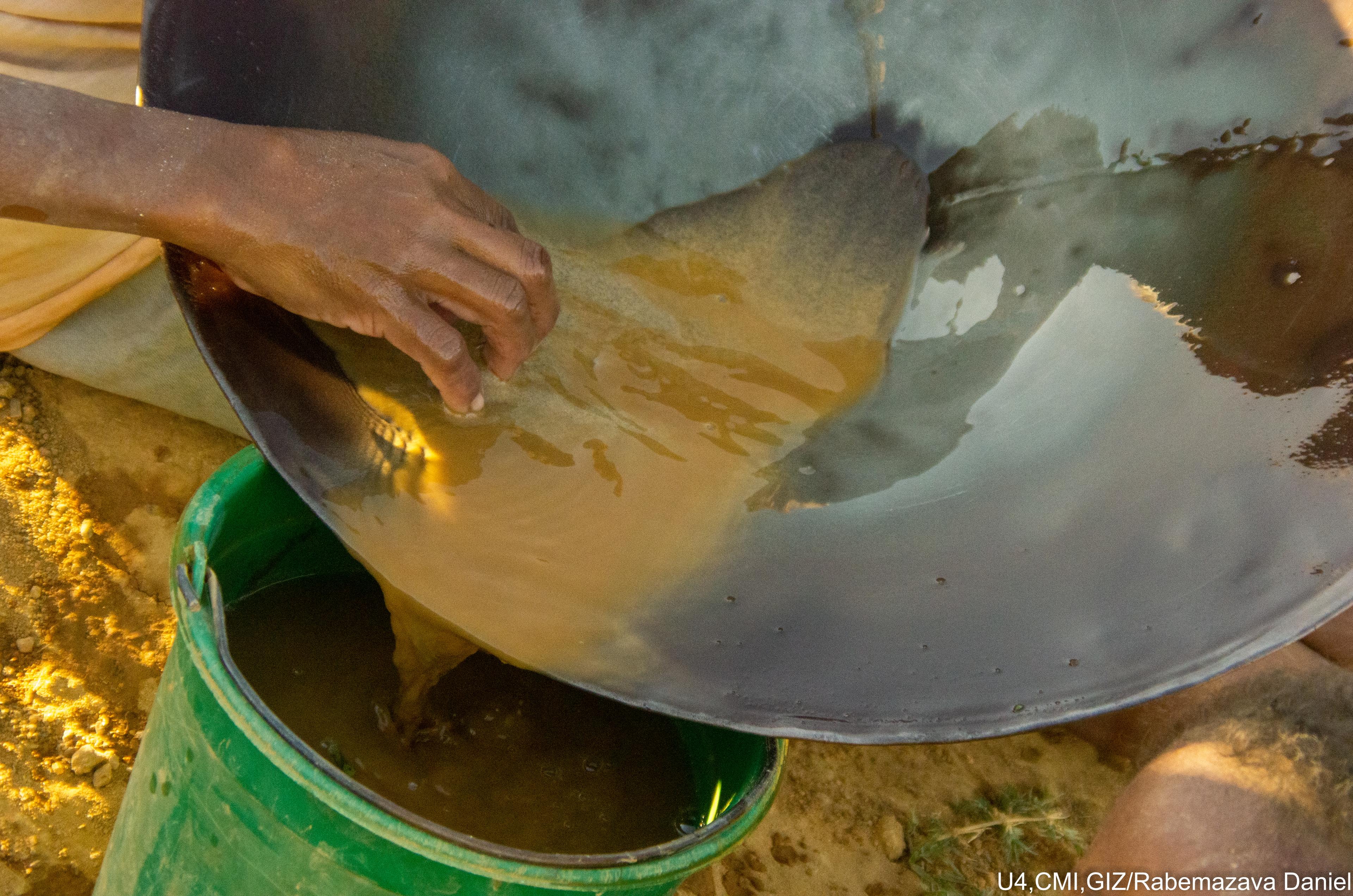This U4 Brief in English is a short version of the full report Le secteur de l’or à Madagascar : au cœur des pratiques illicites. Le cas de Dabolava et Betsiaka, available in French.
Africa loses USD 88.6 billion annually to illicit financial flows. In Madagascar, gold exploitation could be a major source of development for the government and the population in the medium to long term. Unfortunately, the precious metal only makes a small group of people rich and does not contribute to the overall development of the country.
This study aims to provide an in-depth analysis of illicit financial flows related to the artisanal and small-scale gold mining (ASGM) industry in Madagascar.
The state’s commitment to improving governance
The Malagasy state has adopted measures to improve governance in the artisanal and small-scale gold mining industry, such as the introduction of laws relating to the Mining Code and its implementing regulations, the adoption of regulations relating to the gold regime, and the creation of the National Agency for the Gold Industry (ANOR). It has also established a national strategy for the governance of the gold sector, which is to go hand in hand with awareness-raising campaigns to formalise the industry actors’ roles. In addition, the Central Bank of Madagascar set up a national gold reserve in 2020 to harmonise the marketing of gold in Madagascar.
Despite these measures, as of 2020, there is still a huge difference between the official data and the quantities of gold leaving the country. It is estimated that nearly 2 tonnes of gold are smuggled out of Madagascar each year. In addition to illegal gold exports, the Malagasy state lost huge sums of money in 2020 due to the non-repatriation of foreign currency by gold exporters.
While the Malagasy government’s willingness to fight against weak governance in the gold sector is clear, there remains a paradoxical relationship between the series of measures adopted to formalise the gold industry, its low contribution to the state coffers and the trafficking intercepted.
Analysis of illicit financial flows
This study was conducted taking into account the context of the gold sector in Madagascar. The methodological approach used included reviewing the literature on illicit financial flows, identifying the drivers of such flows, conducting visits to selected sites in Dabolava and Betsiaka, and determining the risks and magnitude of illicit financial flows associated with artisanal and small-scale gold mining in Madagascar.
The illicit financial flows analysed in this study refer to corruption, illegal exploitation of natural resources, smuggling and trafficking, money laundering, tax fraud and international commercial fraud.
This analysis shows that both informality and lack of transparency predominates in the gold sector. In addition to the public and private actors recognised by the legal provisions, other actors have been identified whose complicity facilitates gold trafficking.
The main form of illicit financial flows in the gold sector is corruption, which has infected the entire value chain, from the administrative phase of issuing mining permits and operating licences to the export stage. Corruption is a common practice, whether at the extraction sites recognised by the Mining Code, in the mining fields and gold corridors, or at the bedrock (fatana) extraction sites.

Weighing of gold powder brought by a gold panner to a category I collector in Dabolava, Menabe – Madagascar
Credit: Daniel Rabemazava
Table: Summary of illicit financial flows (IFF) risks in the ASGM industry value chain
|
Phase |
The problems identified |
Link with IFF (Yes/No) |
Possible forms of IFF (if applicable) |
Related illicit financial flows |
|
Administrative and installation |
Mechanised gold panning: a silent provision |
Yes |
The authorities can take advantage of the miners’ ignorance of Decree 7903/2013 on mechanised gold panning to abuse their position. The miners, believing that they are in an unofficial position, feel obliged to pay a certain amount to be able to continue mining gold with mechanised tools. |
Corruption |
|
Moratorium on the granting of mining permits |
Yes |
The moratorium on the granting of mining permits has increased the risk of corruption, including political interference and the payment of bribes to speed up the granting of mining permits. |
Corruption |
|
|
Legal vacuum in relation to gold mining in the fatana |
Yes |
This legal vacuum has given rise to several forms of corruption, including favouritism, bribery, influence peddling and abuse of office along the gold value chain.
For example: favouritism by the authorities in the settlement of disputes in the fatana; competition between fatana owners leading to arbitrary arrests; sponsors paying bribes to law enforcement for the custody of a team that found gold in a fatana that was 30 metres deep. In addition, parliamentary assistants are reported to have intervened at local authority level in a conflict settlement in the fatana in exchange for a percentage of production when gold is sold. |
Corruption |
|
|
Low registration rate of gold panners/miners |
Yes |
Gold panners are victims of abuse of power and racketeering by the authorities during checks. |
Corruption |
|
|
Conflicts between fatana/mining permit holders and landowners |
Yes |
Operators (exploration and mining permit holders, fatana holders and gold panners) bribe the authorities to avoid this legal obligation. |
Corruption |
|
|
Exploitation |
Protection provided in the fatana |
Yes |
Collaboration between fatana operators and local authorities: local authorities at district level, law enforcement and magistrates offer support and back-up if there is a dispute in the fatana. In return, they receive their share of production after the gold is sold. |
Corruption |
|
Circulation of cash at fatana level |
Yes/No |
The origin of the funds remains questionable. No money laundering can be confirmed. However, given the dubious origin, there is certainly a suspicion of money laundering. |
Money laundering |
|
|
Sponsors not falling under the Mining Code |
No |
Due to a legal vacuum concerning fatana, it is difficult to establish the type of IFF concerned. |
N/A |
|
|
Gold exploitation within a protected area |
Yes |
Gold extracted from within the protected area is introduced into legal circulation with the complicity of the authorities. Payment of bribes to obtain the certificate of origin. |
Illegal exploitation of natural resources Gold laundering Corruption |
|
|
False declaration regarding the origin of gold from the fatana |
Yes |
Mining infringement. Risk of paying bribes to the municipal official to whom the gold will be declared. |
Corruption |
|
|
Transport |
Use of false passes and/or payment of a bribe |
Yes |
Corruption of law enforcement officials during the transport of gold. |
Corruption |
|
Marketing |
Setting of purchase prices by sponsors |
No |
Legal vacuum |
N/A |
|
Lack of communication between state institutions: municipality, INSTAT (National Institute of Statistics), ANOR, Public Treasury |
No |
Problem with the governance of the Malagasy gold industry. |
N/A |
|
|
Disparate distribution of institutional roles: ANOR and Directorate of Mines |
No |
Problem with the governance of the Malagasy gold industry. |
N/A |
|
|
Circulation of counterfeit notes in the purchase of gold |
Yes |
Problem with the control system at state level. |
Money laundering |
|
|
Conducting collectors’ activities outside authorised locations |
Yes |
Problem with the control system at state level. Payment of bribes to agents who control collectors’ cards. |
Corruption |
|
|
Processing |
Presence of informal craftspeople and jewellers |
Yes |
Conducive to the abuse of office by mining inspectors and the payment of bribes. |
Corruption |
|
Hallmarking: rarely applied by the administration and scarcely respected by jewellers |
No |
It is a mining offence. |
N/A |
|
|
Export |
Payment of bribes at Ivato International Airport |
Yes |
The exporter offers a bribe to the officials in charge of checking the documentation during the gold export procedures. |
Corruption |
|
Reduction in the amount of the purchase invoice which serves as the basis for calculating the mining royalty, which is based on the first sale on export |
Yes |
Deliberate and illegal action by the exporter, leading to a reduction in the amount of the mining royalty |
Tax fraud |
|
|
Undervaluing gold quality |
Yes |
The outdated equipment of the National Laboratory of Extractive Industries cannot identify gold when the quality is higher than 18 carats. |
Tax evasion |
|
|
Influence of political elites on export by air |
Yes |
In collusion with politically exposed persons (PEPs), the exporters allegedly transported gold on board an airline plane without having undergone any type of inspection or paying taxes (possible influence peddling and abuse of office). |
Corruption |
|
|
Gold trafficking by sea, with Nosy-Be and Sainte-Marie as exit points |
Yes |
Violation of the export prohibition regulations. Bribes and influence peddling to get gold out of Madagascar. |
Smuggling and trafficking Corruption |
|
|
Non-repatriation of currency |
No |
Mining infringement. |
N/A |
|
|
Concealment of non-repatriated currency |
Yes |
Proceeds from the sale of non-repatriated gold are used to purchase goods (clothing, phones, electronic equipment, etc.) in the names of Chinese or Malagasy companies, and then exported to Madagascar. These goods are sold wholesale to circulate the funds used and reinvested in gold mining. |
Money laundering |
|
|
Other |
In case of infringement: settlement mechanism |
Yes |
Lack of guidance on the settlement mechanism with the risk of arbitrary decisions and payment of bribes to settle the infringement. |
Corruption |
Certain problems also contribute to illicit financial flows, such as the legal vacuum in relation to gold exploitation in the fatana, the lack of communication between state institutions, the disparate distribution of the roles in institutions, the exercise of collectors’ activities outside authorised locations, and the circulation of counterfeit notes in the purchase of gold.
Recommendations
All forms of corruption and illicit practices associated with the industry, as well as the stages in the value chain where they occur, the methods and mechanisms used, the actors involved, and the institutional points of vulnerability have been highlighted in this analysis. These aspects allow us to understand why and how not only the Malagasy state loses out in gold mining, but also the local population, which should be able to benefit from the fruits of its labour.
Strategic recommendations are provided to the mining administration and all ministries involved in mining activities, based on the factors and problems identified. These recommendations include strengthening communication between state institutions, clarifying roles and responsibilities between institutions in charge of managing the gold sector, and strengthening the capacity of the mining administration to enforce legislation.
Numerous recommendations are also proposed for all actors concerned, at each phase of mining: mining administration, but also the General Tax Directorate, gold panners/miners and sponsors/landowners, decentralised local authorities, civil society organisations, anti-corruption bodies, licensed collectors, and counters, permit holders, the Ministry of Mines and Strategic Resources, ANOR, jewellers, casters.
The effective implementation of these recommendations as well as the strict application of legislation and the fight against corruption should enable the Malagasy state to manage revenues in a more transparent manner so that they can be used for the country’s development, and so that the country as a whole can finally benefit from gold mining.

Sieving sand from a pond to find gold (Diana, Betsiaka, Mantelimara sector).
Credit: Daniel Rabemazava copyrighted
Table of recommendations
|
Actors |
Strategic recommendations |
|
Mining administration – all the ministries involved in mining activities: Ministry of Mines, Ministry of Finance, Ministry of National Defence, Ministry of Justice, Ministry of the Interior and Decentralisation |
|
|
Actors |
Recommendations by phase |
|
Exploitation |
|
|
Mining administration – all the ministries involved in mining activities: Ministry of Mines, Ministry of Finance, Ministry of National Defence, Ministry of Justice, Ministry of the Interior and Decentralisation |
|
|
General Tax Directorate |
|
|
Panners/miners – sponsors and landowners |
|
|
Decentralised territorial authorities: municipality and region |
|
|
Civil society organisations |
|
|
The anti-corruption bodies: BIANCO, SAMIFIN |
|
|
Marketing |
|
|
Mining administration |
|
|
General Tax Directorate and Public Treasury |
|
|
Panners/miners – the collectors |
|
|
Decentralised territorial authorities: municipality and region |
|
|
Civil society organisations |
|
|
The anti-corruption bodies: BIANCO, SAMIFIN |
|
|
Transport |
|
|
Mining administration |
|
|
Licensed collectors and counters, permit holders |
|
|
The anti-corruption bodies: BIANCO, SAMIFIN |
|
|
Processing |
|
|
Ministry of Mines and Strategic Resources, ANOR |
|
|
Jewellers, casters |
|
|
Export |
|
|
Mining administration – Anti-corruption bodies – Ministry of Defence |
|
